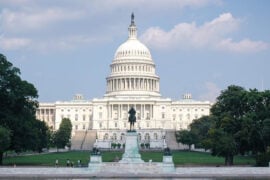In brief
On 19 September 2022, the US Attorney for the District of Montana and the US Department of Justice (DOJ), Antitrust Division (“Division“) filed a criminal information against and plea agreement with the president and owner of a paving and asphalt company (“Company A“) to resolve a charge of attempted monopolization1. The company owner pled guilty to engaging in anticompetitive conduct with the intent to gain monopoly power in the markets for highway crack sealing services in Montana and Wyoming by proposing to a competitor (“Company B“) that they enter into a market-allocation agreement in which the two companies would stop competing against each other by dividing territories in Montana and Wyoming. The company owner also agreed to pay a fine of USD 27,000.
The charge against the company owner resulted from a covert investigation by the US Department of Transportation Office of Inspector General and the Federal Bureau of Investigation.
Contents
Key takeaways
- DOJ has signaled that it intends to revitalize monopolization enforcement.
- DOJ has not obtained a criminal conviction against an individual or corporation in a Section 2 case since 1979.
- The charge against the paving and asphalt company owner marks the Division’s first criminal monopolization case in decades.
- DOJ’s prosecution here demonstrates that it will use Section 2 to pursue attempts to reach illegal agreements among competitors.
- Corporations should consider reviewing their Section 2 risk and implementing appropriate safeguards—including implementing annual assessments of any such risk.
In depth
Section 2 Legal framework
Section 2 of the Sherman Act makes it unlawful for any person to “monopolize, or attempt to monopolize, or combine or conspire with any other person or persons, to monopolize any part of the trade or commerce among the several States, or with foreign nations2.” Attempted monopolization requires proof “(1) that the defendant has engaged in predatory or anticompetitive conduct with (2) a specific intent to monopolize and (3) a dangerous probability of achieving monopoly power3.” It is not necessary to prove that the attempted monopolization was successful4.
A monopolization violation may result in criminal penalties of up to USD 100 million for corporations or USD 1 million for individuals, and up to ten years of imprisonment. Equitable remedies such as disgorgement and restitution may also be available.
Closer analysis of attempted monopolization charge against paving and asphalt company owner
The government specifically alleged that the paving and asphalt company owner had engaged in various calls, some of which were monitored by law enforcement, proposing that Company A and Company B stop competing with each other and divide territories in Montana, Wyoming, and neighboring states. Under this proposed market-allocation agreement, Company B would stop bidding for publicly funded highway crack sealing services projects in Montana and Wyoming, and Company A would pay compensation for Company B’s loss of business in those states. The company owner stated that if the two companies agreed not to compete, their companies’ revenue streams would be more stable and their margins would be higher. Ultimately, Company B refused to enter into the proposed market-allocation agreement.
This guilty plea from this case, follows the Division repeatedly making headlines this year about its revitalized efforts for criminal enforcement of Section 2 of the Sherman Act5 and adding language to its policy manual clarifying that it can bring criminal charges for monopolization6.
Recommended actions
The charge against the paving and asphalt company owner illustrates that where an anti-competitive agreement was not reached and no Section 1 violation actually occurred, the DOJ can still bring Section 2 charges for attempted monopolization. In light of this prosecution and plea agreement, companies should be aware that the DOJ may pursue similar charges in future cases as it continues to ramp up its monopolization enforcement7.
As a result, companies should consider taking steps to mitigate Section 2 liability. In particular:
- Companies should ensure that their antitrust compliance programs include training on appropriate contacts with competitors, including how to report another company’s solicitation to collaborate.
- Companies should develop controls around communications with competitors.
- Companies should analyze the markets in which they operate to assess the level of antitrust risk associated with certain business decisions.
- Companies that have not conducted an annual antitrust risk assessment and compliance review should consider doing so as soon as possible.
1. Paving and Asphalt Company Owner Charged in Attempted Monopolization Scheme (19 September 2022).
2. 15 U.S.C. § 2 (2000).
3. Spectrum Sports, Inc. v. McQuillan, 506 U.S. 447, 456 (1993); see also Competition and Monopoly: Single-Firm Conduct Under Section 2 of the Sherman Act, Chapter 1.
4. See Lorain Journal Co. v. United States, 342 U.S. 143, 153 (1951) (“To establish this violation of § 2 as charged, it was not necessary to show that success rewarded appellants’ attempt to monopolize.”); see also Competition and Monopoly: Single-Firm Conduct Under Section 2 of the Sherman Act, Chapter 1.
5. See, e.g., Assistant Attorney General Jonathan Kanter of the Antitrust Division Delivers Remarks to the New York State Bar Association Antitrust Section (Jan. 24, 2022); Enforcers Summit (4 April 2022); Assistant Attorney General Jonathan Kanter Delivers Keynote at the University of Chicago Stigler Center (April 21, 2022) ; Deputy Assistant Attorney General Richard A. Powers Delivers Keynote at the University of Southern California Global Competition Thought Leadership Conference (June 3, 2022).
7. Similarly, the US Federal Trade Commission has prosecuted invitations to collude as incipient wrongdoing under Section 5 of the Federal Trade Commission Act. See, e.g., In re Valassis Communications, Inc., 141 F.T.C. 247 (2006).






